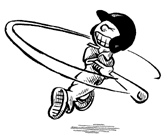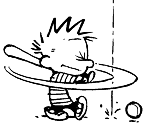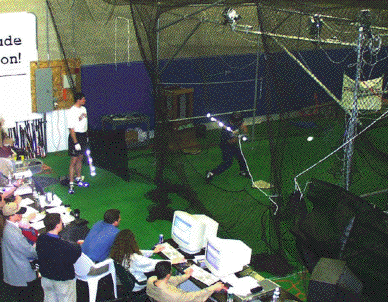
|
Physics and Acoustics of Baseball & Softball Bats
Daniel A. Russell, Ph.D. Graduate Program in Acoustics The Pennsylvania State University The contents of this page are ©2003-2011 Daniel A. Russell | 
|

|
Physics and Acoustics of Baseball & Softball Bats
Daniel A. Russell, Ph.D. Graduate Program in Acoustics The Pennsylvania State University The contents of this page are ©2003-2011 Daniel A. Russell | 
|
Field Measurements of Batted-Ball SpeedIt might seem like the best way to measure batted-ball speed is to conduct field trials where actual players swing bats at pitched balls, and the batted-ball speed is measured directly in the field of play. However, while field testing does provide information about how well a particular bat performs when used for actual play, it is a very costly and difficult process to conduct a meaningful field study of bat performance. The photograph and graphs at right are from the 1997 Brown University field study of baseball bats[1,2] in which 19 players swung one of 6 bats at pitched balls from a pitching machine. The field study was conducted at an indoor batting cate to eliminate the influence of wind and weather. The study took three days and required several computers to control four infrared camera to track the motion of the bats and balls in 3-D. Apprixately a dozen people helped to set things up and to collect the data over the three day period. The actual analysis of the data required several months of computational analysis of the film footage to extract bat and ball trajectories and speeds. Such a study provided useful results for those six bats tested, but the cost (and time) needed to generate performance data for every single bat on the market would make this method of assessing bat performance completely unrealistic as a means of regulating bat performance.Besides the cost and time required to conduct an meaningful field measurement of bat performance there is the problem of repeatability. The plots below right show data for two of the baseball bats tested in this batting cage field study[1,2]. Each data point represents one good impact between bat and ball. Immediately, one can see that not every ball is hit with the same speed. Actual field measurements of hit balls produce a wide range of hit ball speeds. There is a maximum batted-ball speed for each bat, but only a very small number of hits actually produce this maximum value. So, how do we compare bats? Do we use the maximum hit-ball speed from the field trial, the average value, or the range of values? And how many data points are necessary to have statistical confidence in the data? Batted-ball speeds for the wood bat (orange dots) range from 70 to 101-mph, with an average of 91.4-mph. Metal bat M1 (red dots) had batted-ball speeds between 70 and 100-mph with a single hit producing 108-mph. If you ignore this single outlying point, the maximum BBS for the wood bat is actually faster than the maximum BBS for this metal bat. However, the average of all batted-ball speeds for bat M1 was 94.6-mph, shich is 3.2-mph faster than the wood bat. The blue dots for bat M2 are for a very high performance baseball bat* that produced batted-ball speeds between 70 and 107-mph with an average of 101.5-mph. Even though the maximum BBS was around 107-mph, there are many hits producing batted-ball speeds much lower than the maximum BBS for wood. Not every single hit produces the maximum possible batted-ball speed.
The point I wish to make by showing this data is that in order to accurately measure the performance of a bat in a field study, a rather large amount of data must be collected to ensure that the performance quantity (maximum BBS or average BBS) is measured with statistical confidence. The scatter in the data and the number of data points necessary to detect a clear trend is a considerable limitation of field tests as a means of measuring bat performance for regulation purposes. *This particular metal bat is not legal under the current NCAA BESR and MOI performance standards, which were adopted in 1999. The barrel diameter is too large (2.75" instead of 2.625"), the bat is 33" long and weighs 29oz so it fails to meet the "minus three" rule, and it exceeds the maximum BESR limit for 33" bats. |

|
Let's start with the assumption that Batted-Ball Speed is the desired end quantity to regulate, and see what it depends on from a physics perspective. If one starts from basic physics conservation laws (conservation of linear and angular momentum, and the conservation of energy), it is relatively simple to derive the equation for batted-ball speed to be:[3,4]
In all four of the laboratory test standard protocols that are currently being used (ASA BBS, NCAA BESR, USSSA BPF1.20 and Little League BPF1.15) a ball is fired with a speed vball from a cannon towards a bat which is clamped in a pivot so that it is free to rotate after the ball hits it. The bat is initially at rest so vbat=0. This means that the collision efficienty may be simply measured as the ratio of ball speeds after and before the collision with the bat,